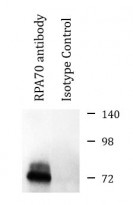ARG54143
anti-RPA70 antibody
anti-RPA70 antibody for ICC/IF,Immunoprecipitation,Western blot and Human,Mouse,Rat,Monkey
Gene Regulation antibody
Overview
| Product Description | Mouse Monoclonal antibody recognizes RPA70 |
|---|---|
| Tested Reactivity | Hu, Ms, Rat, Mk |
| Tested Application | ICC/IF, IP, WB |
| Host | Mouse |
| Clonality | Monoclonal |
| Isotype | IgG2a |
| Target Name | RPA70 |
| Antigen Species | Human |
| Immunogen | Purified recombinant human RPA70 protein fragments expressed in E.coli. |
| Conjugation | Un-conjugated |
| Alternate Names | RP-A p70; Single-stranded DNA-binding protein; RF-A protein 1; Replication protein A 70 kDa DNA-binding subunit; HSSB; RF-A; RP-A; REPA1; Replication factor A protein 1; MST075; RPA70 |
Application Instructions
| Application Suggestion |
|
||||||||
|---|---|---|---|---|---|---|---|---|---|
| Application Note | * The dilutions indicate recommended starting dilutions and the optimal dilutions or concentrations should be determined by the scientist. | ||||||||
| Observed Size | 70 kDa |
Properties
| Form | Liquid |
|---|---|
| Purification | Affinity purified |
| Buffer | PBS (pH 7.4), 0.02% Sodium azide and 50% Glycerol |
| Preservative | 0.02% Sodium azide |
| Stabilizer | 50% Glycerol |
| Concentration | 0.8 mg/ml |
| Storage Instruction | For continuous use, store undiluted antibody at 2-8°C for up to a week. For long-term storage, aliquot and store at -20°C. Storage in frost free freezers is not recommended. Avoid repeated freeze/thaw cycles. Suggest spin the vial prior to opening. The antibody solution should be gently mixed before use. |
| Note | For laboratory research only, not for drug, diagnostic or other use. |
Bioinformation
| Database Links |
Swiss-port # P27694 Human Replication protein A 70 kDa DNA-binding subunit Swiss-port # Q8VEE4 Mouse Replication protein A 70 kDa DNA-binding subunit |
|---|---|
| Gene Symbol | RPA1 |
| Gene Full Name | replication protein A1, 70kDa |
| Background | Plays an essential role in several cellular processes in DNA metabolism including replication,recombination and DNA repair.Binds and subsequently stabilizes single-stranded DNA intermediates and thus prevents complementary DNA from reannealing.Functions as component of the alternative replication protein A complex (aRPA).aRPA binds single-stranded DNA and probably plays a role in DNA repair;it does not support chromosomal DNA replication and cell cycle progression through S-phase.In vitro,aRPA cannot promote efficient priming by DNA polymerase alpha but supports DNA polymerase delta synthesis in the presence of PCNA and replication factor C (RFC),the dual incision/excision reaction of nucleotide excision repair and RAD51-dependent strand exchange. |
| Function | As part of the heterotrimeric replication protein A complex (RPA/RP-A), binds and stabilizes single-stranded DNA intermediates, that form during DNA replication or upon DNA stress. It prevents their reannealing and in parallel, recruits and activates different proteins and complexes involved in DNA metabolism. Thereby, it plays an essential role both in DNA replication and the cellular response to DNA damage (PubMed:9430682). In the cellular response to DNA damage, the RPA complex controls DNA repair and DNA damage checkpoint activation. Through recruitment of ATRIP activates the ATR kinase a master regulator of the DNA damage response (PubMed:24332808). It is required for the recruitment of the DNA double-strand break repair factors RAD51 and RAD52 to chromatin in response to DNA damage (PubMed:17765923). Also recruits to sites of DNA damage proteins like XPA and XPG that are involved in nucleotide excision repair and is required for this mechanism of DNA repair (PubMed:7697716). Plays also a role in base excision repair (BER) probably through interaction with UNG (PubMed:9765279). Through RFWD3 may activate CHEK1 and play a role in replication checkpoint control. Also recruits SMARCAL1/HARP, which is involved in replication fork restart, to sites of DNA damage. May also play a role in telomere maintenance (PubMed:17959650). As part of the alternative replication protein A complex, aRPA, binds single-stranded DNA and probably plays a role in DNA repair. Compared to the RPA2-containing, canonical RPA complex, may not support chromosomal DNA replication and cell cycle progression through S-phase. The aRPA may not promote efficient priming by DNA polymerase alpha but could support DNA synthesis by polymerase delta in presence of PCNA and replication factor C (RFC), the dual incision/excision reaction of nucleotide excision repair and RAD51-dependent strand exchange (PubMed:19996105). [UniProt] |
| Cellular Localization | Nucleus. |
| Research Area | Gene Regulation antibody |
| Calculated MW | 68 kDa |
| PTM | DNA damage-induced 'Lys-63'-linked polyubiquitination by PRPF19 mediates ATRIP recruitment to the RPA complex at sites of DNA damage and activation of ATR. Sumoylated on lysine residues Lys-449 and Lys-577, with Lys-449 being the major site. Sumoylation promotes recruitment of RAD51 to the DNA damage foci to initiate DNA repair through homologous recombination. Desumoylated by SENP6. |
Images (3) Click the Picture to Zoom In
-
ARG54143 anti-RPA70 antibody ICC/IF image
Immunofluorescence: HeLa cells fixed in 1% Paraformaldehyde and stained with ARG54143 anti-RPA70 antibody at 1:100 dilution.
-
ARG54143 anti-RPA70 antibody WB image
Western blot: HUVEC cell lysate stained with ARG54143 anti-RPA70 antibody at 1:2000 dilution.
-
ARG54143 anti-RPA70 antibody IP image
Immunoprecipitation: HeLa cell lysates were immunoprecipitated and stained with ARG54143 anti-RPA70 antibody.








